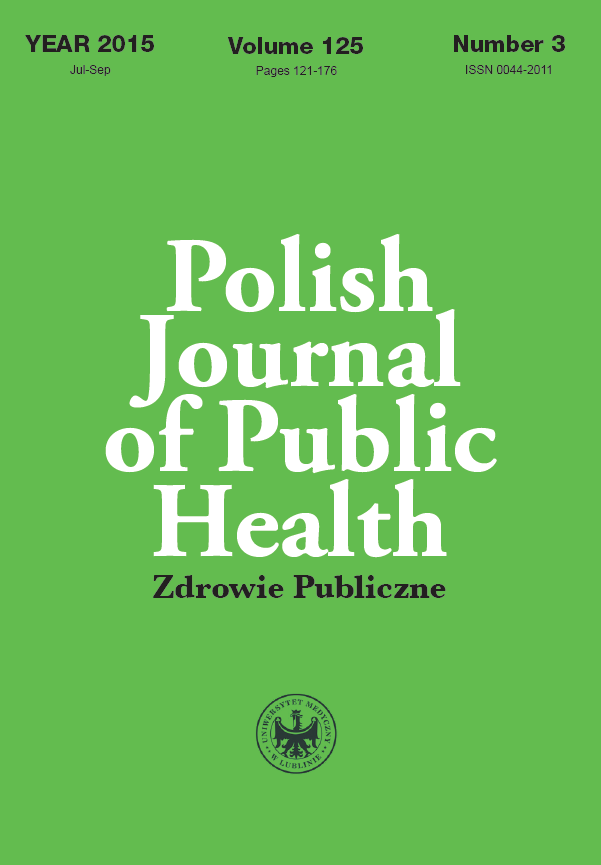Dental caries prevalence in patients treated by dentistry students at a university dental clinic
DOI:
https://doi.org/10.1515/pjph-2015-0043Keywords:
dental caries, DMFT index, dentistry studentsAbstract
Introduction. Dental caries is a serious problem affecting numerous populations around the world. During the last decade, there was a significant increase of its prevalence in many countries. Hence, the dental epidemiological status requires some further analysis.
Aim. This study was designed to assess the prevalence of dental caries among adults of various age and gender groups treated by dental students of English Division at the Chair and Department of Conservative Dentistry and Endodontics of the Medical University of Lublin.
Material and methods. The authors collected and analyzed the dental history of patients who had been treated at the university dental clinic in Lublin throughout 2013 and 2014.
Results and Conclusions. The mean DMFT index of examined group of patients increases with age and it tends to be higher in women than men. Class I dental caries according to Black’s classification was the most prevalent, followed by class II, class III, class V and class IV. Caries tends to affect molars and premolars most commonly. In addition, these teeth were most likely to be extracted and restored.
References
1. Fejerskov O, Kidd EAM. Dental caries. 2 ed, Blackwell Muksgaard Ltd, UK; 2008.
2. Featherstone JD. The continuum of dental caries – Evidence for a dy¬namic disease process. J Dent Res. 2004;83(Spec Iss C):C39-C42.
3. Bagramian RA, Garcia-Godoy F, Volpe AR. The global increase in den¬tal caries. A pending public health crisis. Am J Dent. 2009;22(1):3-8.
4. Oral health information systems, World Health Organization website. [http://www.who.int/oral_health/action/information/surveillance/en/]
5. World Health Organization: Oral health surveys basic methods. 4th edi¬tion. Geneva: World Health Organization; 1997.
6. Chałas R, Maksymiuk P, Fajgier T. The evaluation of kindergarten teachers’ preparation to promote oral health among children. Pol J Pub¬lic Health. 2014;124(1):33-7.
7. Petersen PE. Sociobehavioural risk factors in dental caries – internation¬al perspectives. Community Dent. Oral Epidemiol. 2005;33(4):274-9.
8. Lukacks JR, Largaespada L. Explaining sex differences in ental caries prevalence: saliva, hormones, and ‘‘life-history’’ etiologies. Am J Hum Biol. 2006;18(4):540-55.
9. Szymańska J, Szalewski L. Deciduous teeth caries in the population of Polish children aged 0.5-6 years. Pol J Public Health. 2011;121(1):86-9.
10. Chestnutt IG, Schafer F, Jacobson AP, Stephen KW. Incremental suscep¬tibility of individual tooth surfaces to dental caries in Scottish adoles¬cents. Community Dent Oral Epidemiol.1996;24(1):11-6.
11. Hannigan A, O’Mullane DM, Barry D, et al. A caries susceptibility clas¬sification of tooth surfaces by survival time. Caries Res. 2000;34(2):103-8.
12. Ahovuo-Saloranta A, Hiiri A, Nordblad A, et al. Pit and fissure seal¬ants for preventing dental decay in the permanent teeth of children and adolescents. Cochrane Database Sys Rev. 2008;8(4):CD001830. DOI: 10.1002/14651858.CD001830.pub3.
13. Demirci M, Tuncer S, Yuceokur AA. Prevalence of caries on individual tooth surfaces and its distribution by age and gender in university clinic patients Eur J Dent. 2010;4(3):270-9. PMCID: PMC2897860.
Downloads
Published
Issue
Section
License
Copyright (c) 2015 Polish Journal of Public Health

This work is licensed under a Creative Commons Attribution-NonCommercial-NoDerivatives 3.0 Unported License.


